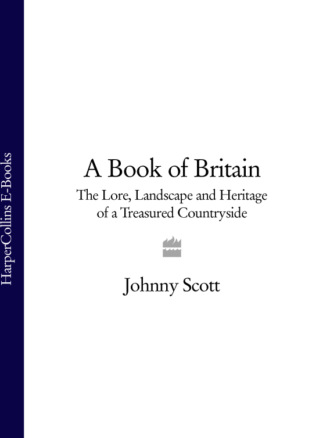
Полная версия
A Book of Britain: The Lore, Landscape and Heritage of a Treasured Countryside

JOHNNY
SCOTT
A BOOK OF
BRITAIN
THE LORE, LANDSCAPE AND HERITAGE OF A TREASURED COUNTRYSIDE
PHOTOGRAPHY BY
Cristian Barnett
For Sallioso
CONTENTS
Cover
Title Page
INTRODUCTION
CHAPTER ONE FARMING AND THE LANDSCAPE
CHAPTER TWO WOODLAND
CHAPTER THREE WEATHER LORE
CHAPTER FOUR WILDLIFE
CHAPTER FIVE WILD HARVEST
CHAPTER SIX FOLKLORE & CUSTOMS
CHAPTER SEVEN CRAFTS
CHAPTER EIGHT COUNTRY SPORTS
Index
Acknowledgements
About the Author
Associations
Copyright
About the Publisher
INTRODUCTION
I was born in February at Hamsland Holt, a farm in that lovely part of the Kent and Sussex Weald, during the great storm of 1948. Family legend has it that my father carried the midwife in through the snowdrifts on his back and that I emerged by candlelight, as the wind howled round the house and heavy flakes battered the window panes. A surviving memento of the occasion rests in my filing cabinet in the form of a large brown envelope on which my father wrote, in his beautiful copperplate handwriting: ‘J. Scott, His Caul, 24 February 1948’. A child born with a caul, or amniotic sack, covering their face is believed in folklore to be protected from drowning – a superstition put to the test some years later when I fell into the Border Esk, a river notorious for its powerful undercurrent, when my father was fishing the Netherby beat.
SHORTLY AFTER MY BIRTH, MY PARENTS MOVED TO SCARLETTS FARM … IT IS HERE THAT THE KALEIDOSCOPE OF CHILDHOOD MEMORIES REALLY STARTS: THE PALE GREEN OF THE NURSERY WALLS AND THE OMNIPRESENCE OF NANNY PRATT; MY OAK-BEAMED BEDROOM AND THE SMELL OF MY MOTHER’S SCENT WHEN SHE CAME TO KISS ME GOODNIGHT.
Shortly after my birth, my parents moved to Scarletts Farm, a larger holding near Cowden with a lake and weir, four cottages, a watermill, an oast house and a beautiful Elizabethan farmhouse with a nursery wing to contain my older sister, myself and a nanny. It is here that the kaleidoscope of childhood memories really starts: the pale green of the nursery walls and the omnipresence of Nanny Pratt; my oak-beamed bedroom and the smell of my mother’s scent when she came to kiss me goodnight; the faces of the people who worked on the farm: Joe Botting, the pig man and gardener; Billy Akehurst, the horseman, who always wore grey Derby tweed breeches and brown leather leggings; and Matt, the cattleman. Other faces are less distinct – Jim Akehurst’s wife Betty, who cleaned, and Mrs Rogers, who cooked and lived in a cottage by the water mill with her father, a First World War veteran who had lost both feet at the Battle of the Somme and got about on leather knee pads. I remember, too, my parents’ closest friends – Robert Clarke, Paul Carver, John Robson, Jimmy Waters and Kemble Watley – warming themselves in front of the big, open inglenook fireplace in the drawing room with its elaborately carved wooden surround, after a day’s shooting or hunting. (The carvings were reputedly the work of Dutch drainage experts, carved in return for a night’s lodging on their journey back to Holland after completing the seventeenth-century Fen drainage schemes.)
There were stables up at the farm yard for the cart horses, my parents’ hunters and an evil-tempered grey pony called Twilight, on whom I hunted for the first time, aged four, when the Old Surrey and Burstow Foxhounds met at the house. This is a memorable occasion because I was led on foot by my perspiring father, who then contrived to be in the right place when the hounds killed and as a consequence I was ‘blooded’ by that marvellous huntsman, Jack Champion. A succession of great lolloping foxhound puppies spring to mind. Traditionally, all Hunts like to send puppies to ‘walk’ with local people for about nine months; it helps the young hound become acclimatised to humans, machinery and farm animals before returning to the discipline of Hunt kennels.
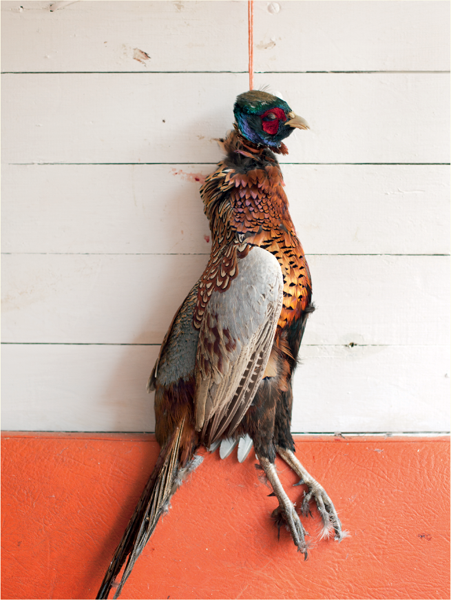
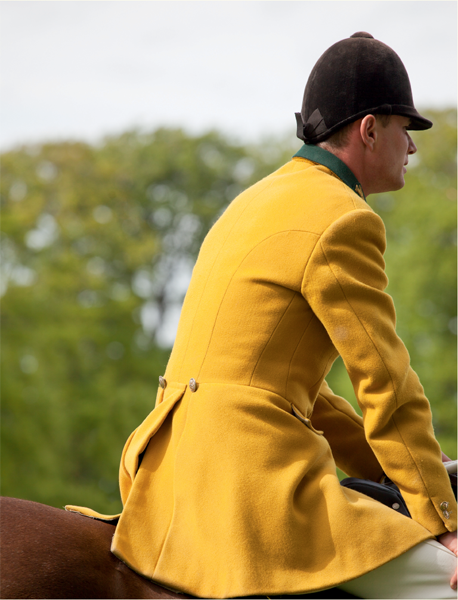
Until the centuries of hunting instinct begin to develop in them, these puppies are as enchanting as any other young animal, and I can remember names such as Outcast and Harmony, Furrier and Falcon, or Dexter and Melody with whom I romped as a child. From the whole family’s perspective, walking a hound puppy is enormously satisfying and enables them to become more involved with their local Hunt. They can see their protégé being judged at the local Hunt puppy shows and it may even graduate to some of the great annual hound shows at Harrogate, Honiton or Peterborough and, of course, they have the pleasure of following its career on hunting days. I can still recall a furious argument with a small girl, both of us aged about five years old, over the relative hunting prowess of ‘our’ individual hounds. Many Hunts present puppy walkers with a keepsake by way of thanks at the annual puppy show, and I have a whole collection of ephemera ranging from silver spoons and cups to engraved glasses and even a snuff box presented to my grandfather engraved: ‘Bolebroke Beagles. 27 April 1932. Best Couple. Bachelor and Blue Beard.’
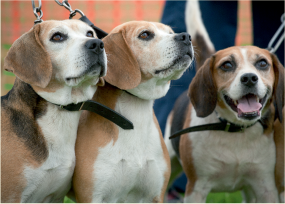
An image of the boot room, with its gleaming rows of hunting boots and gun cabinets, leaps to mind whenever I smell boot polish or Rangoon oil. Here my father’s terriers had their beds: Tweedle, Tory, Tiger and Trooper. These were all taciturn working ‘stable’ dogs, bred from a Sealyham belonging to Jack Champion and a bare-skinned bitch belonging to Frank Chilman, who had been my grandfather’s gamekeeper at our home, Tremains. I learnt my first lesson in the treatment of animals from them; their master’s son I may have been, but that didn’t mean they would tolerate any liberties. I was introduced to wildlife on our afternoon walks through the ancient coppiced woods on the farm with Nanny Pratt. These were not just walks for the good of our health; rationing was still enforced and Nanny Pratt always carried with her a Sussex trug made from willow boards and, depending on the season, she filled it with flowers for the nursery, edible plants, berries or nuts. Trailing along behind her as she foraged, my sister and I quickly learnt to identify what was edible, where to find it, and why it grew there. We soon understood that some plants might look good to eat but are, in fact, deadly poisonous – such as the black or translucent berries of climbing byrony, or the dark purple ones of deadly nightshade – and we knew never to touch those we did not recognise. At the same time, any inquisitive child is bound to take an interest in the wildlife around him or her as they walk, surrounded by birdsong, darting insects and the furtive rustling of unseen little creatures. It was on these outings with Nanny Pratt, as I began to learn about the breeding seasons of animals, that the seeds of my fascination with natural history were sown.
On these afternoon walks we sometimes met others bent on the same mission as ourselves, such as womenfolk from the village or retired farm workers harvesting the hedgerows for a whole range of edible or medicinal plants. In the early autumn there were always families of noisy Cockneys on their traditional holiday, when they came down from the East End to pick hops and apples, who would be searching for blackberries or rosehips along the lanes and in woodland. Later, on 14 September, it was the custom for bus loads of townspeople and their children to descend on the countryside to strip the hazel trees on Nutting Day. The coppiced oak, hornbeam, chestnuts and hazel woodlands were busy places through the winter, as the farm men cut and stacked the poles to dry for fencing materials. Sometimes we would see an old man cutting hazels to make into hurdles, and one winter a group of charcoal burners set up camp, living in wigwam-shaped canvas tents and building their curious earth-covered fires.
THE COPPICED OAK, HORNBEAM, CHESTNUTS AND HAZEL WOODLANDS WERE BUSY PLACES THROUGH THE WINTER, AS THE FARM MEN CUT AND STACKED THE POLES TO DRY FOR FENCING MATERIALS. SOMETIMES WE WOULD SEE AN OLD MAN CUTTING HAZELS TO MAKE INTO HURDLES, AND ONE WINTER A GROUP OF CHARCOAL BURNERS SET UP CAMP.
In 1956 we moved from Scarletts Farm to Eckington Manor, a red-brick Queen Anne House in the village of Ripe, overlooking the long sweep of the South Downs, with better facilities to allow my father to concentrate on breeding hunters and eventers. Here the parameters of my life began to broaden. My family moved south shortly after the First World War, but kept the farms and woodland in Cumberland and Northumberland. There were other family business interests in the north, and every couple of months my father and grandfather would go up there to attend meetings and visit the tenants, sometimes taking me with them. We would travel by train to Carlisle, stay for a few days at the Crown and Mitre Hotel, then drive along the old Military Road beside Hadrian’s Wall to the family farms at Wingates Moor, near Longframlington in Northumberland. My parents were keen on their fishing, and one of the greatest thrills of my young life was being carried onto the Inverness car sleeper at King’s Cross at midnight, falling asleep to the hiss and chuff of the steam engine, and waking up to the grandeur of the Scottish Highlands north of Stirling. On other occasions we drove down to the West Country to stay with my grandparents at Endsleigh, in Devonshire, the stunning ‘cottage orné’ mansion built in 1810 for the Duchess of Bedford, when they took the fishing on the river Tamar. Before my tenth birthday I had seen much of the natural glory of Britain from the chalk downs and wooded valleys of the south, the high fells of Cumbria and Yorkshire and the magnificence of the Cheviot Hills, to the majesty of the Scottish Highlands and the open moors of Dartmoor and Exmoor.
My social perspective expanded when I went to the village school for a short while and met the children of the people who made up our community. In those days 70 per cent of the population were still employed in agriculture and the remainder were the publican, storekeeper, rector, blacksmith, carpenter, and a handful of commuters and retired people. A little later I went to a Dame school in Hailsham, which was attended by the children of the local businessmen and farmers, and then, when I was eight, I was off to boarding school.
All children of my age had one thing in common, regardless of background or whether they were rural or urban: within the code of good manners and respect for the belongings of others, we had the freedom of the countryside and nature was our primary source of entertainment. To be outside enjoying it was considered a healthy, beneficial and profitable way for the young to spend their time. These were the philosophies around which the Scout movement, which did such exemplary work in introducing inner-city children to country lore, had been based. We made camps in the woods and spent hours being eaten alive by midges, watching a badger sett when the sow brought her piglets out at dusk, or a vixen’s earth when she played with her cubs on a summer evening. We caught tadpoles in jam jars in the early spring, watching them grow into little frogs before releasing them back into the wild, and we overturned cowpats to find worms for use as bait when we fished ponds and streams for sticklebacks or eels.
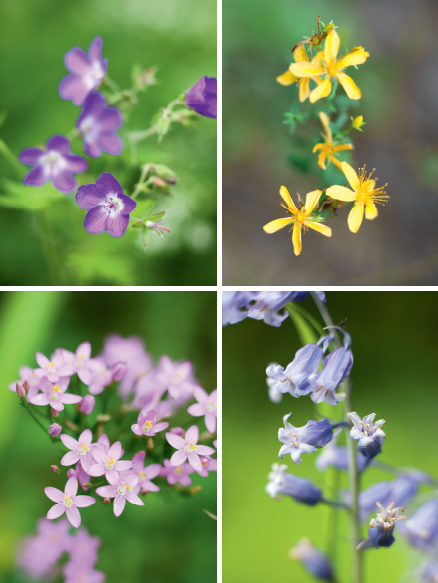
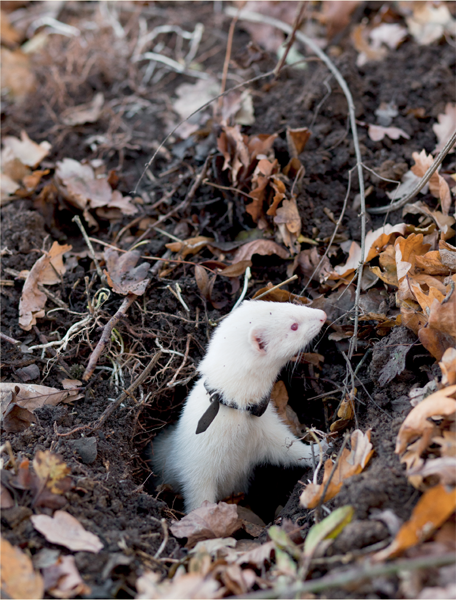
Butterfly and egg collecting were still viewed as acceptable during my childhood, and although this bird nesting was officially banned in 1954 it took a few years before the hobby was finally seen as abhorrent. At one time every child would have been given a butterfly net and specimen jar, or an egg-collecting kit with the little drill for making holes in the shell and a glass ‘blowing tube’ for removing the yolk. The prevalent view in those days was that egg collecting was educational, an opportunity to teach the young how to watch birds returning to their nest sites with nesting material, and that if one egg was subsequently carefully taken from a nest no harm was done as a bird would always lay a replacement.
In due course, Joe Botting, our gardener, began to take me ferreting, and within a year, as with many of my contemporaries, I acquired ferrets of my own and could ferret unattended. Ferreting is a wonderful way for the young of both sexes (my daughter, Rosie, kept ferrets) to learn the responsibility of looking after an animal, and if they have listened to what they have been taught they can have enormous fun hunting with them and experiencing the thrill of bringing something home for the pot. It is also the way in which urban sportsmen have traditionally kept in touch with their rural roots; even today there are more ferrets kept in municipal environments than rural ones.
As children we learnt the seasons of birds, animals, reptiles and insects; the ones that hibernated and those that were nocturnal; the predators, the quarry they hunted and the corridors of safety, such as hedgerows, that smaller animals used as habitat, or links between woodland. We also came to understand how wildlife responded to differing weather conditions, and, most importantly, we learnt to recognise the signs of animal presence. We could all identify the narrow tracks of rabbits leading from their burrows to their feeding grounds, or the broader path of a badger, the three forward and one-heel toe of a pheasant or four-toed narrow pad of a fox crossing a muddy path through a wood. The telltale signs left by the hair of an animal passing under or over a barbed-wire fence or close to brambles would not evade us, nor the fine, soft, grey-brown fluffy hair of a rabbit, the stiff, straight, bristly hair of deer, the long, white and grey of a badger or the short russet of a fox. So, too, could we decipher the messages in their droppings: the twisted dung of a fox, full of fur, bone fragments and seeds, and the acrid stench of his urine, where he marked his territory; the oblong dropping of rats; the long, crinkly, single black dropping of a hedgehog, glinting with remnants of undigested beetle carapaces; the tidy, open latrine of a badger or the stinking, fishy pile of otter spraints on a boulder beside a river; the oval, dark khaki droppings of roe deer or the regurgitated pellets of an owl, full of the tiny bones of shrews and voles. Above all, we learnt that every wild animal relies on sound and scent to warn them of danger, and that silence and a downwind approach were essential if we hoped to watch them.
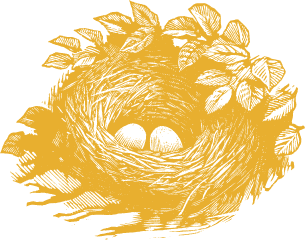
AS A CHILD I GREW UP AT EASE WITH COUNTRY PEOPLE OR THOSE WHO WERE URBAN BASED BUT MADE THE EFFORT TO ENJOY THEIR RURAL HERITAGE. THROUGH HUNTING, SHOOTING AND FISHING I HAD A RANGE OF CONTACTS WHICH EXTENDED FROM LAND’S END TO JOHN O’GROATS, AND IT GAVE ME A WONDERFUL SENSE OF SECURITY, KNOWING THAT I HAD CONNECTIONS WITH COUNTRYMEN THROUGHOUT BRITAIN.
My father was a man of enormous energy who took his duty of stewardship-the historic responsibilities of a landlord towards the land and its people – very seriously and he regarded it as an important part of my early education. He was a Justice of the Peace and sat on the bench every week; he was also a Deputy Lieutenant of the County, Chairman of the Parish Council and his own land agent for the farms and woodland in the north. He served on the Hunt committee, was actively involved in the Pony Club, and each year he was responsible for designing and building a hunter trials course. He bred superb hunters and eventers; hunted, shot, fished and stalked; played for the village cricket team; regenerated the bell tower in St John’s Church opposite our house and rang himself every Sunday. In her own quiet way, my mother was much involved in the church, the welfare of the old people in the village and the early days of Riding for the Disabled.
As I grew older and became more involved in the adult world, I met the ghillies, stalkers, gamekeepers and Hunt servants from whom I learnt the history of mankind’s benign role in managing wildlife. They explained to me how field sports had contributed to the architecture of the landscape and were responsible for creating, preserving and maintaining the habitat of the different species, whether game birds such as pheasants, partridges, grouse or wildfowl, red deer or foxes.
As a child I grew up at ease with country people or those who were urban based but made the effort to enjoy their rural heritage. Through hunting, shooting and fishing I had a range of contacts which extended from Land’s End to John O’Groats, and it gave me a wonderful sense of security, knowing that I had connections with countrymen throughout Britain. I remember being utterly miserable during my first term at boarding school and consoling myself with the thought that, although I had no idea where the school was or how far away it was from my parents, were I to make a break for freedom all I needed to do was find my way to the nearest Hunt kennels, where I would be sure of a safe haven and a route home. Field sports were not seen in isolation in those days, nor had socialist politicians allowed lobbying by a single-issue animal rights group to create an ethnic minority among country people; they were, and still are, the catalyst that binds many communities together and provides them with the folklore that defines their regional identity.
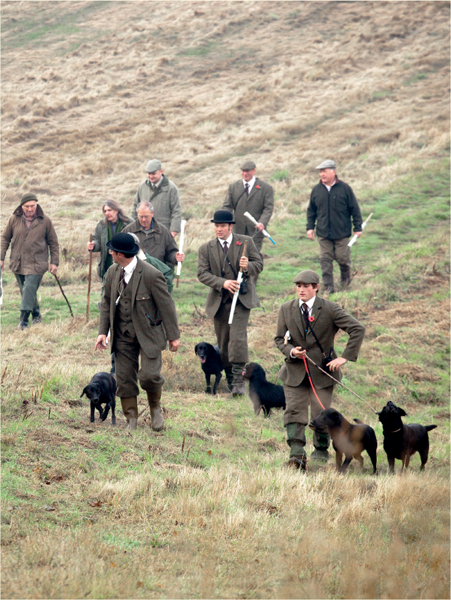
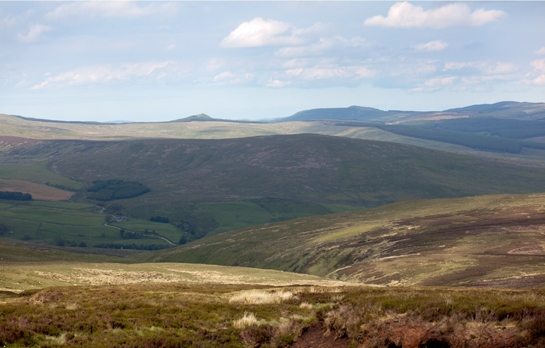
AS MACHINERY INCREASINGLY REPLACED MANPOWER, 50 PER CENT OF THE AGRICULTURAL WORKFORCE LEFT THE LAND TO FIND ALTERNATIVE EMPLOYMENT IN TOWNS. THE SELF-SUPPORTING INFRASTRUCTURE OF VILLAGES BECAME ERODED, MANY OF THE OLD CRAFTS DIED OUT AND MUCH COUNTRY LORE, HANDED DOWN FROM GENERATION TO GENERATION, WAS LOST.
The post-war arcadia of my childhood was about to undergo dramatic changes; during the fifties, sixties and seventies the government policies of agricultural intensification created a chain reaction of loss across the spectrum of wildlife. Vast quantities of habitat were destroyed in parts of Britain, as hedgerows were bulldozed out, old pasture, heath and downland ploughed and marshes drained under devastating Ministry of Agriculture reclamation schemes. Herbicides and pesticides killed the food source of many small birds, reptiles and mammals; this in turn impacted on the larger species that depended on them. At the same time, the Forestry Commission embarked on a massive programme of planting quick-growing Sitka spruce conifers. Huge tracts of land were planted, much of it in areas of outstanding natural beauty which are totally unsuited to growing trees, the Highlands of Scotland, for example, or the moorlands of Wales and England – Kielder Forest alone sprawls over 250 square kilometres of the Northumbrian hills. Rural communities disappeared; acres of ancient natural woodlands were engulfed, and in a matter of twentyyears these plantings had grown into vast blocks of sterile woodland.
As machinery increasingly replaced manpower, 50 per cent of the agricultural workforce left the land to find alternative employment in towns. The self-supporting infrastructure of villages became eroded, many of the old crafts died out and much country lore, handed down from generation to generation, was lost. As agricultural reclamations destroyed the hedgerows and small broadleaved woodlands, they took with them the urban tradition of picking nuts and berries every autumn. Gradually, the much-vaunted urban-rural divide became established.
There were great changes afoot in my own life. After I left school I travelled in South Africa, Australia and New Zealand, working my way around as a stockman on a vast sheep station in Western Australia, as a cook and miner in an iron-ore mine, a jackaroo on a sheep and cattle ranch, a lumberjack, a non-union docker all the usual odd jobs that people of my age did to earn enough to travel on to the next place on the atlas. When I arrived home, not only was the countryside I knew undergoing enormous changes, but the family farms had gone, and with them my assumption that I would, one day, take over the running of the farms in Northumberland. Uncertain of my next career move, I was persuaded to try the City, a way of life to which I was totally unsuited and unable to settle into. The call of the hills and wide open spaces drew me back to the north, and after a year studying hill and upland sheep, and beef management at the Northumberland College of Agriculture, I found a partnership in a hill farm on the Lammermuirs. These heather-clad hills in southern Scotland were to be my home for the next twenty-five-years, and would be the place where I brought up my children.
Hill farming fascinates me; it is archaic and, despite advances in veterinary science, has remained virtually unchanged since the Cistercian monks established their great flocks on the hills in the eleventh century. The sheep are practically wild animals, and to farm them at all on the open, unfenced hills, a shepherd needs to be as much a naturalist as a stockman. I love the broad perspective, the chuckle of grouse, the comings and goings of the migratory nesting birds – the snipe, curlew, oystercatchers, plovers, redshanks and skylarks who break the long silence of winter with their exuberant birdsong in the spring. Modernity made its brutal impact even on this pastoral paradise: farm prices fell and hill communities halved as one shepherd, supplied with an all-terrain quad bike, now had to do the same-job that two had previously done.
One of the strangest aspects of farming in Britain since the War has been a complete turnaround in agricultural policy. I have witnessed the farming community being paid huge subsidies in order to inflict great damage to the surface of the landscape, and in a matter of a few decades those same farmers have been paid even larger sums to put it back again. The countryside will never be quite what it was in my childhood, but then, nothing stands still, however much one may want it to. What is important now is that the nation is aware of the fragility of what we have left of our natural heritage and that it must be cherished. The countryside is now seen as a force for good, and the communities that live there, their customs and traditions, worth supporting. Technology has enabled more and more people with urban-based employment to live in rural areas and to reap the benefits of the countryside for themselves and their children. What seems so sad to me is that many of the people who seek the pastoral idyll feel alien in the midst of their natural heritage. A combination of bureaucracy, ill-advised agricultural policies and a lack of understanding have gone a long way to hide the precious secrets of our sceptred isle. It is all still there, though – the romance, antiquity and beauty – just waiting to be found.
And Nature, the old nurse, Took The child upon her knee, Saying, ‘Here is a story book Thy Father has written for thee.’ HENRY WADSWORTH LONGFELLOW (1807–82)




